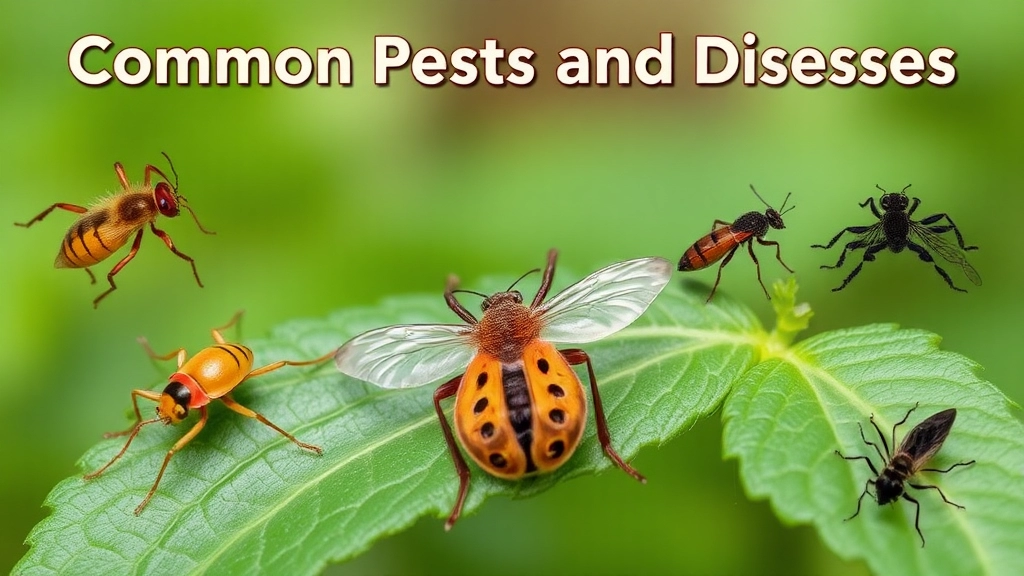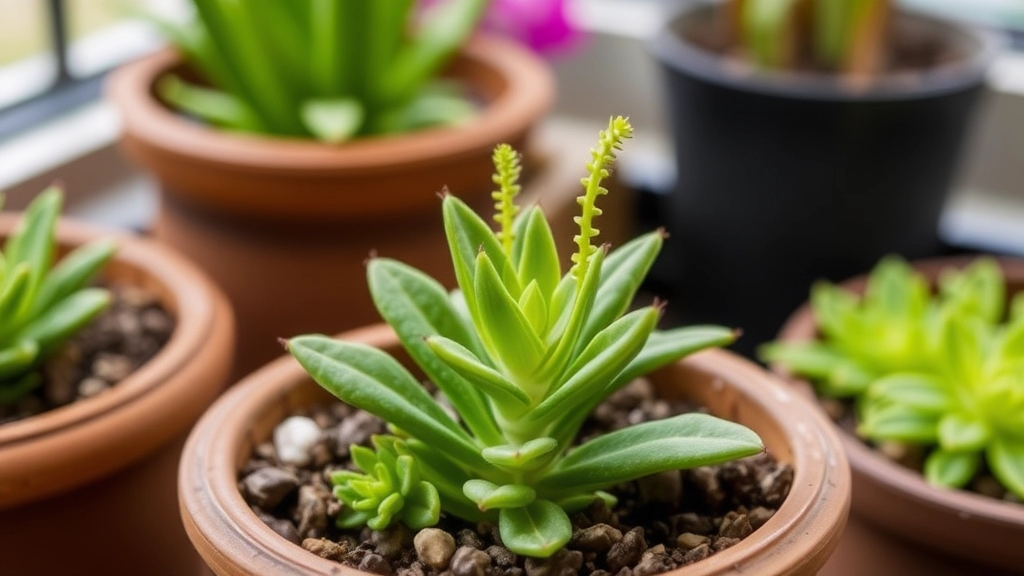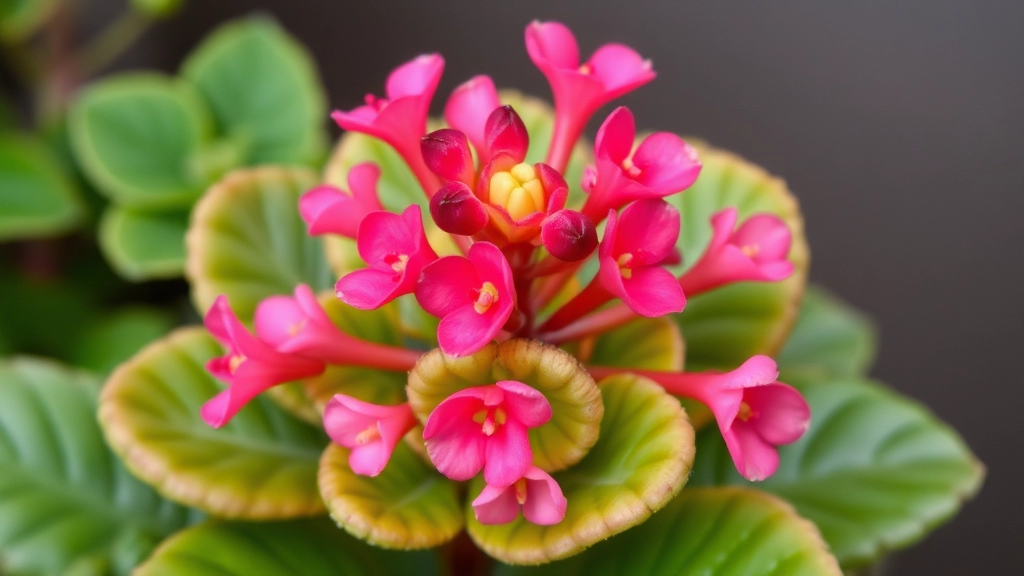Kalanchoe Mother of Thousands
As an avid plant enthusiast, I’m thrilled to share my insights on the fascinating Kalanchoe Mother of Thousands. This remarkable succulent has captured the hearts of many gardeners with its unique characteristics and easy-care nature. In this article, we’ll explore the plant’s distinctive features, propagation techniques, and essential care tips.
From its ability to produce countless plantlets along its leaf edges to its resilience in various growing conditions, the Kalanchoe Mother of Thousands is truly a marvel of nature. Whether you’re a seasoned plant parent or a beginner, this article will provide you with valuable information to help your Mother of Thousands thrive and multiply, turning your space into a lush, green paradise.
Characteristics of Kalanchoe Mother of Thousands
Alright, let’s dive into the fascinating world of Kalanchoe Mother of Thousands. This plant’s got some seriously cool characteristics that’ll make you want to add it to your indoor jungle ASAP.
Ever seen a plant that’s basically a living, breathing baby-making machine? That’s the Mother of Thousands for you. This succulent’s got a few tricks up its sleeve that’ll blow your mind.
Unique Leaf Structure
First off, those leaves are something else. They’re not just pretty to look at; they’re the plant’s secret weapon for reproduction. Along the edges of each leaf, you’ll spot tiny plantlets. Yep, you heard that right – baby plants growing right on the leaves. It’s like nature’s version of a cloning experiment gone wild.
Rapid Growth and Reproduction
Speaking of cloning, this plant doesn’t mess around when it comes to multiplying. Those little plantlets I mentioned? They drop off like it’s hot and start growing wherever they land. It’s like the plant version of “be fruitful and multiply” on steroids.
Appearance and Size
Now, let’s talk looks. The Mother of Thousands is a real looker:
- Tall and slender stems
- Thick, fleshy leaves (usually green, but sometimes with a reddish tinge)
- Can grow up to 3 feet tall (that’s about as tall as your average toddler)
Flowering Habits
While it’s not known for its flowers, when it does bloom, it’s a sight to behold. We’re talking clusters of pinkish-red bell-shaped flowers that’ll make you do a double-take.
Adaptability
This plant’s tough as nails. It can handle a bit of neglect and still look like a million bucks. Perfect for those of us who sometimes forget we even have plants (guilty as charged).
So, there you have it – the Mother of Thousands in all its glory. It’s a plant that’s always ready to party and multiply, making it a fun addition to any indoor garden. Just be careful where you put it, or you might end up with more plants than you bargained for!
Growing Conditions and Requirements
Let’s talk about what Mother of Thousands needs to thrive.
These plants are tough cookies, but they’ve got their preferences.
Light:
- They love bright, indirect sunlight
- Can handle some direct sun, but not too much
- If leaves turn red, they’re getting too much light
Soil:
- Well-draining soil is key
- Mix cactus soil with perlite for best results
- Avoid heavy, water-retaining soils
Water:
- Less is more with these succulents
- Let the soil dry out between waterings
- Overwatering is their worst enemy
Temperature:
- They’re happy in normal room temps
- Can’t handle frost, so keep them above 10°C (50°F)
- Ideal range is 16-24°C (60-75°F)
Humidity:
- Not fussy about humidity
- Average indoor levels are fine
- Can handle dry air like a champ
Fertiliser:
- Feed sparingly during growing season
- Use a balanced, water-soluble fertiliser
- Dilute to half strength to avoid burning
Remember, Mother of Thousands is a low-maintenance plant.
It’s perfect for busy folks or those new to plant parenting.
Just give it the basics, and it’ll reward you with loads of little plantlets. If you’re interested in other low-maintenance succulents, you might want to check out the Kalanchoe tomentosa propagation guide. For those looking for a unique variety, the Kalanchoe beharensis fang care article offers valuable insights.
Propagation Techniques
Let’s chat about how to spread the love with Mother of Thousands. Trust me, it’s a piece of cake!
Plantlets: Nature’s Little Helpers
You know those tiny plants growing on the leaf edges? They’re your ticket to more Kalanchoes. Here’s the deal:
- Wait until they’re about 1cm big
- Gently pluck them off
- Pop them on some moist soil
- Keep ’em warm and slightly damp
Boom! In a few weeks, you’ve got new plants. It’s like magic, but it’s just nature doing its thing.
Leaf Cuttings: The DIY Approach
Fancy a bit more hands-on action? Try leaf cuttings:
- Snip a healthy leaf
- Let it dry for a day or two
- Stick it in some well-draining soil
- Water sparingly
Before you know it, you’ll see tiny roots and leaves popping up. It’s like watching your own little plant nursery come to life!
Stem Cuttings: For the Impatient Gardener
Want faster results? Stem cuttings are your best bet:
- Cut a 10cm stem piece
- Remove lower leaves
- Plant in moist soil
- Keep warm and humid
In about a month, you’ll have a new plant ready to go. It’s like fast-forwarding the whole process!
The Secret Sauce: Patience and Care
Look, propagating Mother of Thousands isn’t rocket science. But here’s the kicker – it’s all about patience and a bit of TLC. Treat these little guys right, and they’ll reward you with a whole army of plants.
Remember, every plant’s a bit different. Some might take off like a rocket, others might need a bit more coaxing. That’s the fun of it – you never know what you’re gonna get!
So, ready to give it a go? Trust me, once you start propagating Mother of Thousands, you’ll be hooked. It’s addictive, in the best way possible. Before you know it, you’ll be the go-to plant guru in your circle. How cool is that?
Common Pests and Diseases

Hey there, plant lovers! Let’s chat about the pesky problems that can bug our Kalanchoe Mother of Thousands.
These tough little succulents are pretty resilient, but they’re not invincible.
Pests and diseases can still crash the party if we’re not careful.
So, what should we keep an eye out for?
Mealybugs: The Sneaky Invaders
These tiny white fluffballs love to hide in leaf joints.
They suck the life out of your plant, literally.
Spot them early, and you can wipe ’em out with a cotton swab dipped in rubbing alcohol.
Spider Mites: The Invisible Threat
These microscopic menaces leave tell-tale webbing on your plant.
They thrive in dry conditions, so keep that humidity up!
A good shower can often knock them off their game.
Root Rot: The Underground Menace
This is what happens when we love our plants a bit too much with water.
Overwatering leads to soggy soil, and that’s a recipe for root rot.
The fix? Let the soil dry out between waterings, and make sure you’ve got good drainage.
Leaf Spot: The Unsightly Blemish
Fungal infections can cause dark spots on leaves.
It’s often due to water sitting on leaves or high humidity.
Prune affected areas and improve air circulation to keep this at bay.
Prevention is Key
Regular checks and good plant hygiene go a long way.
Keep your Mother of Thousands in well-draining soil and bright, indirect light.
Don’t overwater, and you’ll avoid most of these headaches.
Remember, a healthy plant is a happy plant, and a happy plant is more resistant to pests and diseases.
Keep these tips in mind, and you’ll be well on your way to mastering the care of your Kalanchoe Mother of Thousands. If you’re interested in exploring other varieties, you might want to check out the flowering Kalanchoe blossfeldiana for a colorful addition to your collection.
Tips for Indoor Care
Alright, let’s chat about keeping your Mother of Thousands happy indoors. I’ve been growing these quirky succulents for years, and I’ve picked up a few tricks along the way.
Light: The Secret Sauce
First things first – these guys love light. But here’s the kicker:
- Direct sunlight can scorch ’em
- Too little light makes ’em leggy
So, what’s the sweet spot? A bright spot near a window, but not right in the sun’s firing line. I’ve got mine chilling on a shelf about 3 feet from a south-facing window, and they’re thriving.
Watering: Less is More
Here’s where most folks trip up. These succulents are drama queens when it comes to water:
- Overwatering = root rot (trust me, been there, done that)
- Underwatering = they’ll survive, but look a bit sad
My golden rule? Water when the top inch of soil feels dry. In winter, I cut back even more. It’s like they’re hibernating, so they need less of everything.
Soil: The Foundation of Success
Don’t just chuck ’em in any old potting mix. They need:
- Well-draining soil (I mix regular potting soil with perlite)
- A pot with drainage holes (non-negotiable)
Temperature: Keep it Cosy
These aren’t Arctic explorers. They prefer:
- 60-75°F (15-24°C)
- No sudden temperature drops
I once left mine near a drafty window in winter. Big mistake. They dropped leaves faster than a tree in autumn.
Humidity: Not Fussy
Good news – they’re not humidity divas. Average room humidity is fine. No need for misting or humidifiers here.
Fertiliser: The Cherry on Top
A little boost goes a long way:
- Use a balanced, water-soluble fertiliser
- Feed monthly during growing season
- Skip it in winter
Pro tip: I dilute the fertiliser to half strength. Better to underfeed than overfeed.
Pruning: Keeping it in Check
These plants can get a bit wild if left unchecked. Don’t be shy about:
- Pinching off leggy growth
- Removing dead or yellowing leaves
- Cutting back if it’s getting too tall
Remember, every bit you prune can potentially become a new plant. It’s like free plants!
Repotting: Give ’em Room to Grow
They’re not fast growers, but they do need a bit more space every couple of years:
- Choose a pot 1-2 inches larger
- Spring is the best time to repot
- Be gentle with the roots
Last time I repotted mine, I found it had barely filled its old pot. But the fresh soil gave it a new lease on life.
Keeping your Mother of Thousands happy indoors isn’t rocket science. It’s all about finding that sweet spot of light, water, and care. Get these basics right, and you’ll have a thriving, quirky plant that’s always ready to chat about (well, if plants could chat). Remember, every plant’s a bit different, so don’t be afraid to tweak these tips to suit your specific Mother of Thousands. Happy growing!
Benefits of Growing Mother of Thousands

Ever wondered why people go nuts for Mother of Thousands? Let me spill the tea.
First off, these plants are tough as nails. Seriously, they’re like the Chuck Norris of the plant world.
You can forget to water them for weeks, and they’ll just shrug it off. Perfect for us plant-killers, right?
But here’s the kicker – they’re not just hardy, they’re gorgeous too.
Those cascading leaves? Instagram gold, mate.
And don’t get me started on how easy they are to propagate. It’s like they do all the work for you.
Got a mate who’s into plants? Boom, instant gift.
Plus, they’re air purifiers. Yep, they’re cleaning your air while looking pretty. Talk about multitasking.
Oh, and for all you busy bees out there – these plants are low maintenance AF.
No need for fancy fertilisers or daily care routines. They’re the ultimate “set it and forget it” plant.
But here’s my favourite bit – they’re conversation starters.
Trust me, when people see those tiny plantlets growing on the leaves, they’ll be full of questions.
So, if you’re looking for a plant that’s tough, pretty, and a bit of a show-off, Mother of Thousands is your gal. It’s a close relative of the Kalanchoe pinnata, which is known for its medicinal properties.
It’s like having a plant and a party trick all in one. What’s not to love? If you’re interested in other unique Kalanchoe varieties, check out the Kalanchoe beharensis felt plant for a different but equally fascinating species.
Troubleshooting Common Issues
Let’s face it, even the toughest plants can throw us a curveball now and then. Mother of Thousands is no exception. I’ve had my fair share of “what the heck?” moments with this plant, and I bet you have too. So, let’s dive into some common hiccups and how to sort them out.
Yellowing Leaves: The SOS Signal
Ever walked up to your Mother of Thousands and thought, “Why’s it looking a bit yellow?” Here’s the deal:
- Overwatering: This is usually the culprit. These succulents hate wet feet.
- Nutrient deficiency: Sometimes, they’re just hungry.
- Too much sun: Yep, even sun-lovers can get a nasty burn.
Fix: Ease up on the watering, give it a bit of fertiliser, or move it to a slightly shadier spot. Simple, right?
Leggy Growth: The Stretch Armstrong Effect
If your plant’s looking like it’s trying to reach the ceiling, it’s probably not getting enough light. I once had a Mother of Thousands that looked like it was auditioning for a basketball team.
Fix: Move it closer to a window or invest in a grow light. Trust me, it’ll perk right up.
Pest Invasions: The Unwelcome Guests
Mealybugs and spider mites love to crash the party. They’re like those relatives who overstay their welcome.
Fix:
- Isolate the plant (no one likes a pest spreader)
- Wipe down leaves with rubbing alcohol
- If it’s bad, break out the insecticidal soap
Root Rot: The Silent Killer
This is the big bad wolf of the plant world. By the time you notice, it might be too late. But don’t panic!
Fix:
- Remove the plant from its pot
- Cut away any mushy, black roots
- Repot in fresh, well-draining soil
Remember, prevention is better than cure. Always use a pot with drainage holes and a soil mix that doesn’t hold water like a sponge.
Leaf Drop: The Great Escape
Sometimes, leaves just decide to jump ship. It’s normal to a degree, but excessive leaf drop is a cry for help.
Fix: Check your watering habits, light levels, and temperature. One of these is likely off-kilter.
Bottom line? Most issues with Mother of Thousands boil down to water, light, or pests. Get those right, and you’re golden. And remember, every plant parent has their moments. The key is to learn from them and keep growing (pun intended). Now, go show that Mother of Thousands who’s boss!
Safety and Toxicity Concerns
Let’s chat about the Mother of Thousands plant. It’s pretty, but it’s got a dark side.
Is it safe to have around? Well, not really.
This plant’s toxic. To humans and pets.
Why? It’s got some nasty chemicals in it.
If you eat it, you’re in for a bad time. Think nausea, vomiting, and heart issues.
Got kids or pets? Keep this plant out of reach. Or better yet, don’t have it at all.
What if someone eats it? Call poison control. Fast.
Handling the plant? Wear gloves. Some folks get skin irritation.
Thinking of growing it outside? Think twice. It can spread like wildfire.
In some places, it’s even considered invasive. Not cool for the local ecosystem.
Bottom line: Mother of Thousands looks cool, but it’s risky.
Want a safer houseplant? Plenty of non-toxic options out there.
Remember, a pretty plant isn’t worth a trip to the hospital.
Stay safe, plant lovers. Mother of Thousands might not be your best friend.
FAQs about Kalanchoe Mother of Thousands
Q: Is Kalanchoe Mother of Thousands easy to care for?
A: Yes, it’s very low-maintenance. It’s drought-tolerant and can handle some neglect, making it perfect for beginners or busy plant parents.
Q: How often should I water my Mother of Thousands?
A: Water sparingly, allowing the soil to dry out between waterings. In general, once every 2-3 weeks is sufficient, less in winter.
Q: Can I grow Mother of Thousands outdoors?
A: Yes, but be cautious. It can be invasive in some regions. It’s best suited for USDA zones 9-11 and should be grown in containers to control its spread.
Q: Why is it called Mother of Thousands?
A: It gets its name from its unique ability to produce hundreds of tiny plantlets along the edges of its leaves, which can grow into new plants.
Q: Is Mother of Thousands toxic?
A: Yes, all parts of the plant are toxic if ingested. Keep it away from children and pets.
Q: How do I propagate Mother of Thousands?
A: It’s incredibly easy! Simply collect the plantlets that fall from the leaves and place them on soil. They’ll root quickly.
Q: Does Mother of Thousands flower?
A: Yes, but it’s rare indoors. When it does flower, it produces pinkish-red bell-shaped blooms on tall stalks.
Q: How big does Mother of Thousands grow?
A: It can grow up to 3 feet tall in ideal conditions, but is usually smaller when grown indoors.
Q: Can Mother of Thousands survive in low light?
A: While it prefers bright light, it can tolerate lower light conditions. However, it may become leggy and produce fewer plantlets in low light.
Q: How often should I repot my Mother of Thousands?
A: Repot every 2-3 years or when the plant outgrows its current pot. Spring is the best time for repotting.
References
-
Missouri Botanical Garden – Kalanchoe daigremontiana Mother of Thousands

